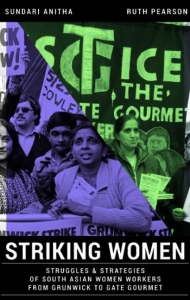Book Review | Striking Women: Struggles and Strategies of South Asian Women Workers from Grunwick to Gate Gourmet by Sundari Anitha and Ruth Pearson
In Striking Women: Struggles and Strategies of South Asian Women Workers from Grunwick to Gate Gourmet, Sundari Anitha and Ruth Pearson offer an in-depth examination of two strikes – the Grunwick strike of 1976–78 and the strike at Gate Gourmet in 2005 – to highlight how South Asian migrant women have contributed to the struggle for workers rights in the UK. Praising the book’s incorporation of the wider social and historical context, Amal Shahid finds this an informative and accessible read for those passionate about the history and sociology of labour, gender and migration studies.
 Picture: (BruceEmmerling CCO)
Picture: (BruceEmmerling CCO)
Striking Women: Struggles and Strategies of South Asian Women Workers from Grunwick to Gate Gourmet. Sundari Anitha and Ruth Pearson. Lawrence & Wishart. 2018.

Much of the debate surrounding Brexit has focused on immigration and the role of existing migrants in the UK. Given this backdrop, Sundari Anitha and Ruth Pearson’s new book Striking Women informs our understanding of the latter by highlighting the ways in which South Asian migrant women have contributed not only to the UK economy but also to the struggle for worker rights. Through the case studies of two strikes – namely, the Grunwick strike of 1976–78 and the strike at Gate Gourmet in 2005 – the book illuminates the participation of South Asian women in industrial activism in the Fordist and Post-Fordist eras. The publication of the book coincides with the fortieth anniversary of the Grunwick strike, when migrant women fervently engaged in trade unionism to mark their position in worker movements.
The book begins with a vivid description of the Grunwick strike of 1976–78, followed by an outlining of the events at Gate Gourmet in 2005. As in most industries, the companies in both cases aspired to reduce labour costs and increase profits. The Grunwick strike took place in August 1976 at the film processing plant in Willesden, North London, against the coercive attitude of the management towards their employees. Jayaben Desai, the leader of the strike, aimed to restore ‘the dignity of the workers who were systematically mistreated by their employer and his representatives’ (2). Similarly, the employees of Gate Gourmet, an airline catering company that prepared meal trays for flights, protested against redundancy after the company laid off workers and reduced pay. After a Compromise Agreement was negotiated, out of the 800 dismissed, all but 200 workers were reinstated, 56 of whom protested and picketed for four years (5–6). In both cases, the outcomes were unfavourable, with the blame being largely placed on the feeble support from trade unions.
The book focuses on two sets of migrant streams: first, the ‘twice-migrants’ of India forced to migrate from East Africa, who were the main participants in Grunwick, and second, the Punjabi migrants directly settled in the UK who were involved in the Gate Gourmet strike. The two strikes, although 30 years apart, were similar on many levels. In the face of constant unfreedom in the workplace, ‘informal mechanisms of collective bargaining’ became a compelling mode of resistance. The plurality of experiences that is central to this research also determined the aftermath of the strikes, where some benefited despite the failure of the strike while others struggled.
The story unfolds by providing detailed background on the migrants, their culture and their testimonies pertaining to the events leading up to the strikes. Excerpts from the interviews, along with factual details, draw attention to changes in labour and migration policies in the UK. Following the first half of the book, a series of images of pamphlets and cartoons about Grunwick provides the reader with a glimpse into some documentary evidence and popular culture adaptations of the strikes. The second section of Striking Women discusses the two strikes in detail, concluding with reflections on their aftermath and the future of trade unionism in the UK.
Methodologically, the analysis is based on a life history approach: about 32 workers and three senior officials of the Transport and General Workers Union were extensively interviewed over a period of two years, in addition to a thorough investigation of the legal proceedings and judgments regarding the two strikes. The literature that informs the study is also carefully curated by interspersing testimonies from the interviews in each chapter. Unlike previous studies on the subject, the book attempts to examine the events of the strikes in a wider context and through the personal experiences of the migrant women. In this manner, the study fills the gap in the literature on these strikes by according agency to the women participants.
The authors identify two major problems with the existing discourse surrounding the Grunwick strike: one, the narrative has been commanded by white male voices; and two, it has been assumed that the strike was a glorious moment that successfully represented all minority rights (8). While acknowledging the importance of the event for minority worker rights and feminism among South Asian women, the authors also discuss its limitations. In particular, the authors underline how the later strike at Gate Gourmet also ignored the most vulnerable in the workforce:
The dominance of white male voices has not disturbed the symbolism of the strike leader Jayaben Desai as the emblematic South Asian woman who took on all comers in the fight to expand unionization in the UK workforce. But very often it seems that much of this celebration focuses on a single woman, rather than the integration of all South Asian and black women into the narrative about industrial resistance and militancy in the intervening decades (7).
Overall, the research seeks to challenge stereotypes about South Asian migrant women in the UK. The authors explain how South Asian women are typically perceived as victims of patriarchy, as being dependent on male members of the family and unable to break free of cultural boundaries (10). The prevalent literature therefore concentrates on ethno-religious aspects of diaspora in the UK, rather than ‘material issues of work’ (18) and the ability of migrant women to claim public spaces.
Interestingly, the testimonies in each chapter of Striking Women present a complex picture. The initial chapters focus on the theme of gender, following the motivations of South Asian migrant women to join the workforce and the role of ethnic networks that enabled them to obtain jobs. Concentrating on female agency achieves the goal of subverting the image of the docile South Asian woman burdened by patriarchy, but, at the same time, it also highlights how agency, even in the case of Desai, was often derived from the validation of a male family member. Another common issue was the management of work alongside the household, the latter oftentimes the sole responsibility of the woman. Thus, the study brings forth the duality of migrant women moving beyond their traditional roles as homemakers by asserting agency at work, but being held back by patriarchy at home. At several junctures during the strike process, patriarchy was used to silence the protesting women, elucidating the struggles these women endured at home and at work for their rights. For example, the managers, familiar with the ‘policing’ of South Asian women by their families, attempted to shame the protestors into silence by threatening to complain to their husbands or parents, particularly exaggerating the interactions of the women with other men (125–26).
Some significant concerns are highlighted through these life histories that also suggest material for future research. Firstly, the theme of racism within ethnicity and class, informed by stereotypes in the workplace for minority workers, is an interesting thread that could have been further probed. The study hints at the segmentation of the labour market, but does not explicitly address its existence. Secondly, the anecdotes presented in the book clearly suggest the ubiquity of caste in daily life choices, but this is seldom directly examined. The study concentrates on attitudes towards South Asian migrant women, but caste, in a way, was the stereotype of many of these women. Finally, the research testimonies speak to the existence of various forms of feminism; how the feminism of South Asian women may have differed from that of other migrants may be an intriguing avenue to explore.
In conclusion, the excerpts from the interviews, albeit repetitive at times, demonstrate how these events inculcated confidence and a sense of liberation in the workplace among South Asian working women. They help tie together political and individual agency, thereby rejecting the image of the passive South Asian woman. Simultaneously, the study draws out the limitations of trade unions and the hypocrisy of their inclusiveness. Contrary to studies that inevitably fixate on the event of Grunwick itself, this research is truly historical for its outstanding incorporation of the wider context. Striking Women hence provides an informative and accessible read for those passionate about the history and sociology of labour, gender and migration studies.
This review gives the views of the author, and not the position of Democratic Audit. It was first published on the LSE Review of Books blog.
You can read a feature essay written by the book’s authors here.
Amal Shahid is a PhD Candidate in the Department of International History and a Teaching Assistant for Interdisciplinary Masters Programmes at the Graduate Institute of International and Development Studies, Geneva. Her thesis focuses on casual labour in public works in nineteenth-century colonial India. Her broad interests include political economy, social history, development policy, economic anthropology and the sociology of gender and caste. Read more by Amal Shahid.





 Democratic Audit's core funding is provided by the Joseph Rowntree Charitable Trust. Additional funding is provided by the London School of Economics.
Democratic Audit's core funding is provided by the Joseph Rowntree Charitable Trust. Additional funding is provided by the London School of Economics.